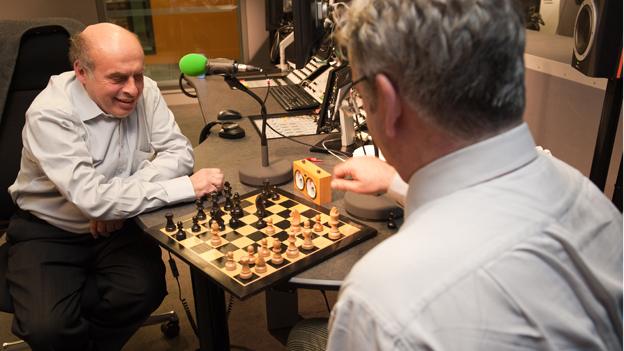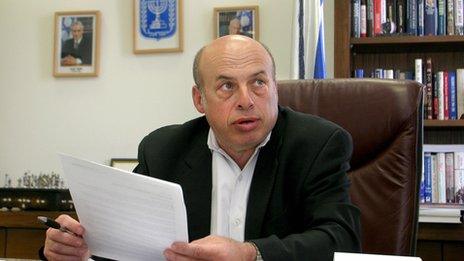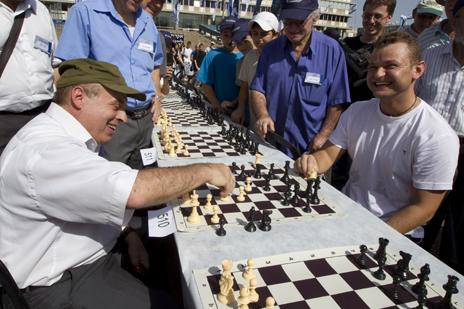Natan Sharansky: How chess kept one man sane
- Published

Chess kept Russian human rights activist Natan Sharansky sane throughout his imprisonment by the Soviets, writes David Edmonds.
"Don't disturb me, I'm playing chess."
Natan Sharansky's jailers took that as powerful evidence that he was going - or had already become - quite mad. After all, in his punishment cell there was no bed, chair or table, let alone a chessboard and pieces. In fact, it was chess that kept him sane.
A human rights activist campaigning for the rights of Jews to emigrate to Israel, Sharansky was sentenced in 1977 on a fabricated charge of spying for the Americans. He spent nine years in a Siberian prison. Half of that was spent in solitary confinement and for more than 400 days he was locked in a punishment cell, given barely any food and clothes so thin that in the winter it amounted to a form of torture.
As a child he'd been a chess prodigy and, aged 14, he became champion of his native Ukrainian town, Donetsk. He could play several games simultaneously in his head (without looking at a board) - a flashy but useless skill, he always thought. "But in prison it became clear why I needed this," he recalls. In his dark, empty, freezing punishment cell, with no-one to talk to, where he was forbidden to read or write, he played games in his head, obviously having to move for both sides, white and black: "Thousands of games - I won them all."
In arguably the best work of fiction written about chess, Stefan Zweig's The Royal Game, the main character, Dr B, has a different experience. Like Sharansky, he too is a prisoner. Like Sharansky he spends all his time playing chess. But unlike Sharansky, the game eventually drives him crazy.
Zweig's novella taps into a well-established popular image of the mad chess player. "There is nothing abnormal about a chess player being abnormal. This is normal," suggested Russian-born Vladimir Nabokov, author of the chess-based novel The Luzhin Defence.

Sharansky, pictured in 2005, while serving as an Israeli minister
That prejudice has been reinforced by the antics and behaviour of some elite grandmasters. Two well-known examples are from the US. Both the great Paul Morphy, in the 19th Century, and the infamous Bobby Fischer, in the 20th Century, were recluses, and both descended into paranoia.
It wouldn't be surprising if chess drove some people insane. The intense focus required for chess, the gruelling mental strain of tournaments, the search - move after move, hour after hour - for the best continuation from within a near-infinite set of possibilities, all this might be expected to produce neurotic symptoms.
In fact, what's remarkable is not that some chess players exhibit varying degrees of eccentricity or pathology but that the vast majority remain rational and emotionally adjusted.
Indeed, one international master, Bill Hartston, once said of chess that it doesn't turn sane people mad, it keeps mad people sane.
But in Sharansky's case it kept a sane person sane. During his lengthy incarceration, "the KGB hoped that I would feel weaker and weaker mentally. Actually I felt stronger and stronger". The KGB played games with their captives, of course, games that were rather more savage than those confined to the 64 squares.
Before his imprisonment Sharansky had developed a computer programme to play chess endgames. This involved "decision tree analysis", or, as Sharansky puts it, "building a logical set of aims and the means to reach these aims". Each time Sharansky was hauled in front of the KGB, he adopted the same strategy to resist their pressure, working out what his objective was, and how he could accomplish it. "That's how I answered all my 125 interrogations," he says.
Aspects of Sharansky's character, which made his will impossible for the Soviet authorities to break, are evident in his chess. He's competitive, a risk taker, obdurate and fearless. He's determined to be the best.

Sharansky enjoys a tournament in Israel
Some of this can be traced to his upbringing. Jews faced institutionalised discrimination in the Soviet Union, and his parents instilled in him a lesson. The only way to combat anti-Semitism was to be supreme in whichever career he chose. Sharansky originally wanted to be the world chess champion. Realising that this wasn't going to happen, he moved into maths and physics. And after it became clear that he wasn't going to be the best physicist in the world, he jokes: "I decided to become the number one political prisoner."
When he eventually made it to Israel he entered politics, taking contentious hawkish positions on several issues, and rising to the office of deputy prime minister. His release in 1986 had supplied one of the most memorable images of the Cold War.
It occurred on an icy day in February at Berlin's Glienicke bridge, dividing East from West. Exchanged for two Soviet spies, Sharansky was ordered by his minders to go straight across the bridge. That was a mistake.
If you demand of Sharansky that he advance like a rook you should expect him to move instead like a bishop or knight. As Sharansky walked across the bridge he did a defiant little zigzag.
Follow @BBCNewsMagazine, external on Twitter and on Facebook, external
On a tablet? Read 10 of the best Magazine stories from 2013 here